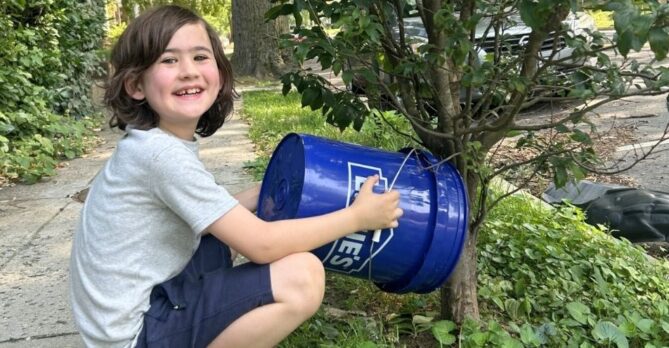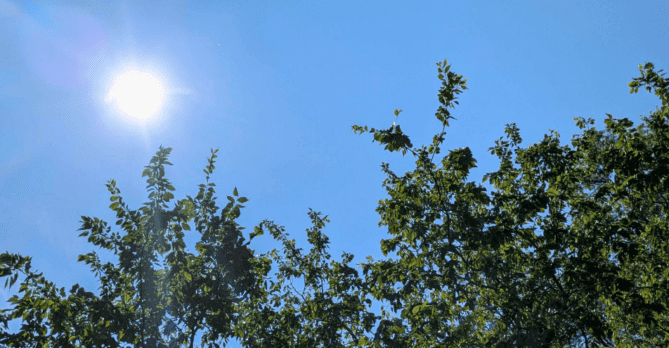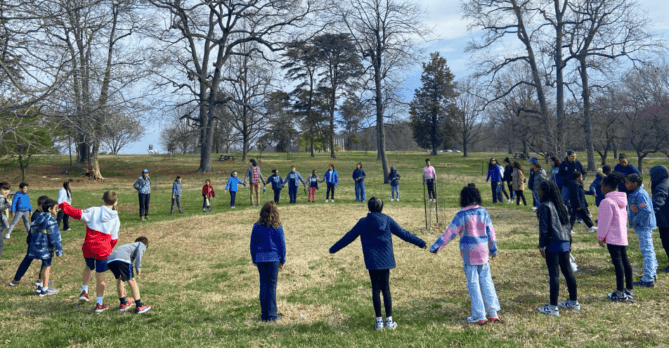
It’s July in Washington, DC. The sun is blazing, the pavement is sizzling, and even the pandas at the National Zoo are fanning themselves (okay, maybe not literally, but who would blame them?). As heat records tumble and summer days stretch hotter and longer, finding relief from the heat and humidity is a must. When outside, the simple act of finding shade is emerging as both a necessity and a survival strategy in our rapidly warming world. Shade is more than comfort; it’s a vital resource for public health, urban livability, and climate resilience.
Shade can make all the difference on a hot day. Think about the moments when you feel you can’t go on without it: a picnic in the park would fizzle without a tree’s shade, the sweltering Metro platform where a sliver of shadow becomes prime real estate, or the city block where every step in the sun saps your will to keep walking. Shade can mean the difference between delightful and dire.
But not every corner of DC has the same amount or quality of shade. And though we may not realize it, shade’s presence (or absence) shapes our city in more ways than meets the eye.
Mapping Shade in the Nation’s Capital
In urban areas, shade is more than a relief from summer heat — it’s a matter of health, environmental justice, and quality of life. American Forests and the UCLA Luskin Center for Innovation have developed the national Shade Map, an innovative tool that reveals just how much — or how little — shade exists across over 360 U.S. cities. This Shade Map, integrated with the Tree Equity Score platform, allows users to see where trees or buildings provide shade, track distribution at different times of day, and pinpoint “shade deserts” — urban areas lacking adequate shade coverage.
Shade is measurable, and so are its benefits. The Tree Equity Score uses factors like tree canopy area, surface temperature, income, employment, race, age, language, and health to assign a 0-100 score, clearly showing communities where shade — and the trees that provide it — are lacking.
A screenshot from the Shade Map below shows noon-time shade of Washington, DC.

Notice that the Northwest corner of our city is well shaded, as are pockets of areas throughout the city that are close to forested areas or parks. If you live west of 16th Street NW, chances are you have no problem finding a shady spot on a hot summer’s day. The Northeast areas of DC are by far the least shady, which leads to urban heat that can be up to 17 degrees hotter than the cooler areas of the District. Northeast neighborhoods like Eckington, Ivy City, Michigan Park, Queens Chapel, Edgewood, and Bloomingdale are just some of the neighborhoods in need of shade.
Not All Have Access to Shade
Despite its importance, the distribution of shade is deeply inequitable in urban areas. Tree cover and shaded infrastructure are often less prevalent in lower-income and marginalized neighborhoods, exacerbating health and environmental disparities. As climate change accelerates, ensuring universal access to shade should become a core part of public health and urban resilience planning.
Below are three areas of DC that starkly show this shade gap: Chevy Chase (NW DC), Eckington (NE DC), and Anacostia (SE DC).



But the benefit goes beyond numbers. The subjective sensation of “cool relief” that accompanies stepping under a tree or awning is a clear indicator of how crucial shade is to our well-being. Studies confirm that shade can move our experience of the environment from unbearably hot to warm, directly improving physical and mental comfort.
Not All Shade is Made Equal
Engineered shade, like pergolas or shade sails, or shade from buildings, can supplement natural shade but rarely matches the urban cooling effects of well-placed trees. While buildings or engineered shade are often more opaque than a tree canopy and may provide relief from the sun for those in its shadow, they can rarely offer consistent shade throughout the day. And as built structures that absorb and radiate heat, they often actively contribute to the urban heat island effect themselves.
Take, for example, the Northeast DC neighborhood of Eckington, pictured below, and its shade coverage at 12pm, 3pm, and 6pm, respectively. At noon, of the 15% total shade coverage, shade from buildings covers just 1% of the total area, while trees cover 14%. As the day progresses from 3pm to 6pm, the total area shaded by trees remains constant, while the shade from buildings can only truly contribute to the total later in the day, when the buildings can cast longer shadows. This shade comes too late, long past when urban surfaces like roads, sidewalks, and the buildings themselves have absorbed heat, which they will continue to radiate through the evening (what we call the urban heat island effect).
Trees, however, offer consistent, reliable shade all day long.

Click to enlarge.

Click to enlarge.

Click to enlarge.
Furthermore, trees actively cool surrounding areas. Shade from tree canopies can reduce ambient air temperatures by up to 10°F and lower ground temperatures by up to 25°F, significantly mitigating the urban heat island effect. At noon, studies show that trees generate 25 times more shade than buildings, underscoring the unique role of urban forestry.
FIND YOUR SHADY SPOT
In short, shade isn’t just a summer perk in DC, it’s an essential civic resource, deserving equitable investment and thoughtful stewardship if every Washingtonian is to enjoy its cool, comforting touch. The amount of shade in your neighborhood, and the benefits it provides to the city and our collective human health, is also directly associated with the number of trees in your neighborhood, contributing to a healthy and robust tree canopy.
Want to see how shady your neighborhood is? Explore the Tree Equity Map. Just enter your address, zoom in to your local area, and turn on the shade map layer.
Ready to increase the amount of shade in your community? We all have the power to make a difference, starting in our own backyards. DC residents can plant free trees on their property through DOEE’s RiverSmart program. Go to caseytrees.org/free to apply!


